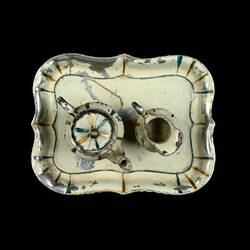Further Media
Sebastian Köpcke (*1967), Volker Weinhold (*1962) | Photographers
We are more familiar with painted tin from tin figures. In this case, however, material and technique were used as furnishings for a doll’s house. Almost everything in such a house is like in real life – only smaller. And it can thus also be presumed in this case that the children who played with their doll’s house offered their guests hospitality with this service just as their parents did with their visitors. This is because children making use of household goods and furnishings was as much enabled as the playful practice of “adult” manners and routines.
Like in the big world, the inventory also grows in the doll’s house and toy shop over generations. And the doll’s houses that come to museums are almost never in their original style or homogeneous. Most tend to consist more of a conglomeration from various times, used by several generations.
This was also the case with the small convolute of doll’s house accessories consisting of fifteen inventory numbers that was given to the museum in 1973 – probably by the former doll mother – and was surely played with for more than one generation.
Producer unknown
MATERIAL & TECHNIQUE
tin, cast, painted
DIMENSIONS
pot H 3.7 cm, small pot H 2.2 cm, tray H 0.6 x W 7.2 x D 5.5 cm
MUSEUM
Museum für Sächsische Volkskunst
PLACE, DATING
Germany, 1900-1920
INVENTORY NUMBER
G 5281
